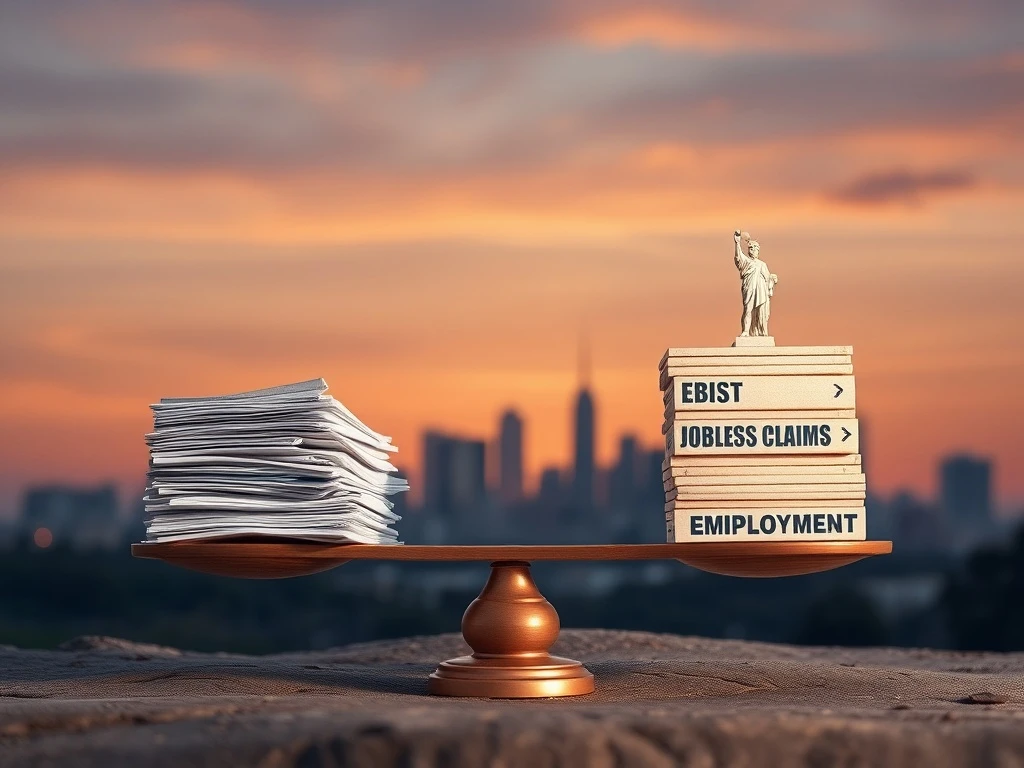The **US labor market** continues to defy expectations. Despite ongoing economic uncertainties, a striking trend persists: jobless claims remain remarkably low. This surprising stability has many analysts pondering the unique characteristics of the current economic climate. Indeed, the United States appears to operate within a distinctive ‘low-hire, low-fire’ labor market, a phenomenon worth examining closely.
Understanding the Current US Labor Market Landscape
Recent data consistently show a surprising resilience in employment figures. Weekly jobless claims, a key indicator of layoffs, have stayed near historical lows. This pattern suggests that employers are largely holding onto their existing workforce. Consequently, widespread layoffs, often feared during periods of economic slowdown, have simply not materialized.
This situation contrasts sharply with previous economic downturns. Historically, a weakening economy would quickly translate into rising unemployment. However, the current environment presents a different picture. Many businesses seem hesitant to let go of valuable employees. This cautious approach reflects lessons learned from the post-pandemic hiring scramble. Finding skilled workers proved incredibly difficult and expensive. Therefore, retaining talent has become a top priority for many firms.
Jobless Claims Remain Surprisingly Subdued
Weekly reports on initial jobless claims offer crucial insights into the health of the **US labor market**. These numbers track new filings for unemployment benefits. Consistently, the figures have hovered well below levels typically associated with a contracting economy. For instance, recent weeks have seen claims remain under 250,000, a level indicating robust employment conditions.
This stability is particularly noteworthy. Many economists had predicted an uptick in claims by now. Concerns about inflation, interest rate hikes, and global instability suggested a cooling labor market. Yet, the data tells a different story. This persistent low level of claims underscores employers’ reluctance to shed staff. It also highlights a cautious optimism among businesses regarding future demand.
Consider these key points regarding jobless claims:
- They serve as a real-time gauge of layoffs.
- Low numbers indicate employers are retaining workers.
- The current figures defy traditional recessionary signals.
- This trend suggests a tight labor supply remains.
The ‘Low-Hire, Low-Fire’ Phenomenon in the US Labor Market
The term ‘low-hire, low-fire’ accurately describes the prevailing dynamics in the **US labor market**. It means that while companies are not engaging in aggressive hiring sprees, they are also refraining from significant layoffs. This cautious equilibrium has become a defining feature of the post-pandemic economy. Businesses are prioritizing stability over rapid expansion or contraction.
This phenomenon stems from several factors. Firstly, the lingering memory of labor shortages during the pandemic is powerful. Companies struggled immensely to fill open positions. They invested heavily in recruitment and training. Therefore, they are reluctant to repeat that costly process by letting go of experienced staff. Secondly, economic uncertainty makes businesses more conservative. They prefer to operate with existing teams rather than gamble on future demand.
Furthermore, the demographics of the workforce play a role. An aging population means fewer new entrants are joining the labor force. This structural constraint makes every skilled worker more valuable. Employers understand this scarcity. They are willing to absorb some costs to keep their teams intact. Consequently, the labor market exhibits a sticky quality, resistant to rapid shifts.
Factors Driving This Unique Labor Market Dynamic
Several underlying forces contribute to the current state of the **US labor market**. Understanding these factors helps explain why jobless claims remain low and why the ‘low-hire, low-fire’ model persists. These elements interact to create a unique economic environment.
One major factor is the persistent labor shortage. Even with some economic cooling, the number of available workers remains insufficient for many industries. This scarcity gives employees more leverage. It also makes employers think twice before initiating layoffs. They know replacing talent will be difficult and expensive.
Another significant element is corporate caution. Businesses experienced rapid shifts in demand during the pandemic. They learned to be more agile and less reactive. Now, they are often absorbing minor dips in demand by reducing hours or slowing down new projects, rather than cutting staff. This cautious approach helps maintain workforce stability.
Moreover, strong balance sheets among many companies allow for greater resilience. Many firms built up cash reserves during the pandemic. This financial buffer enables them to weather periods of slower growth without resorting to immediate layoffs. They can afford to retain employees, even if productivity temporarily dips.
Finally, evolving employee expectations also play a part. Workers now demand more flexibility and better benefits. Companies recognize that a positive work environment fosters retention. They invest in employee well-being to avoid turnover. This commitment to their workforce helps keep layoff numbers down.
Implications for Workers and the Broader Economy
The ‘low-hire, low-fire’ nature of the **US labor market** carries significant implications. For workers, it generally means greater job security. They face a lower risk of sudden unemployment. This stability can reduce financial stress and encourage consumer spending. It also allows for more long-term career planning.
However, this stability also presents challenges. New job opportunities may be less abundant. Individuals seeking to switch careers or enter the workforce might find fewer openings. Wage growth could also moderate if competition for jobs decreases. Yet, the overall picture for employed individuals remains positive.
For the broader economy, this labor market stability offers a crucial buffer against recession. Consumer spending, a major driver of economic growth, tends to hold up well when people feel secure in their jobs. Businesses also benefit from retaining institutional knowledge and avoiding costly retraining. This consistency helps prevent a downward spiral of job losses and reduced demand.
However, it also implies slower economic dynamism. Less hiring means fewer new ventures or rapid expansions. Innovation might proceed at a more measured pace. Policy makers must consider these trade-offs. They aim to balance stability with growth and dynamism. The current situation suggests a careful balancing act is underway.
Looking Ahead: Potential Shifts in the US Labor Market
While the current ‘low-hire, low-fire’ trend seems entrenched, the **US labor market** is not static. Several factors could influence its future trajectory. Monitoring these potential shifts is crucial for businesses, workers, and policymakers alike. The economy remains dynamic, and adjustments are always possible.
One potential shift involves the Federal Reserve’s monetary policy. Continued interest rate hikes could eventually dampen demand more significantly. This might force some companies to re-evaluate their staffing levels. However, the Fed’s recent actions suggest a more cautious approach, aiming for a ‘soft landing’ rather than a sharp contraction.
Technological advancements, particularly in artificial intelligence, also pose a long-term influence. AI could automate certain tasks, potentially impacting job roles. However, it could also create new opportunities. The net effect on employment remains a subject of ongoing debate. Businesses are slowly integrating these technologies.
Global economic conditions also play a role. Geopolitical events or slowdowns in major trading partners could affect US businesses. This might lead to adjustments in hiring and firing practices. Supply chain issues, though easing, could resurface, impacting production and labor needs.
Finally, demographic changes will continue to shape the labor market. The ongoing retirement of baby boomers will sustain pressure on labor supply. This long-term trend supports the idea of continued worker scarcity. Therefore, the ‘low-fire’ aspect might persist for quite some time, even if hiring picks up.
In conclusion, the current state of the **US labor market** reflects a unique blend of caution and resilience. Jobless claims remain surprisingly low, indicating a strong commitment from employers to retain their workforces. This ‘low-hire, low-fire’ environment provides stability for many, even as it presents different challenges for job seekers. Understanding these dynamics is essential for navigating the evolving economic landscape. The stability observed now could set the stage for future growth, albeit at a measured pace.
Frequently Asked Questions (FAQs)
1. What does ‘low-hire, low-fire’ mean for the US labor market?
The ‘low-hire, low-fire’ dynamic means that companies are neither aggressively expanding their workforce nor conducting widespread layoffs. They are largely maintaining their existing staff levels. This reflects caution in hiring new employees while also prioritizing the retention of current talent due to past hiring difficulties and future uncertainties.
2. Why are jobless claims still low despite economic concerns?
Jobless claims remain low primarily because employers are reluctant to lay off workers. Many businesses remember the challenges of finding skilled labor post-pandemic. They prefer to retain staff, even during periods of slower growth, to avoid future recruitment costs and ensure they have the necessary talent when demand rebounds. Strong corporate balance sheets also provide a buffer.
3. How does this labor market affect job seekers?
For job seekers, a ‘low-hire’ environment can mean fewer new job openings or slower hiring processes. While competition for existing roles might be high, the overall stability reduces the risk of widespread layoffs. Individuals looking for new opportunities might need to be more patient or adapt their search strategies.
4. Is this ‘low-hire, low-fire’ trend sustainable long-term?
The sustainability of this trend depends on several factors. Persistent labor shortages and corporate caution suggest it could continue for some time. However, significant economic shifts, such as a deeper recession, aggressive monetary policy, or rapid technological disruption, could alter these dynamics. Demographics, however, suggest continued pressure on labor supply.
5. What are the main benefits of a stable US labor market?
A stable **US labor market** provides significant benefits. It offers job security for workers, which supports consumer confidence and spending. For businesses, it helps retain valuable institutional knowledge and avoids the high costs of recruitment and training. This stability acts as a buffer, making the overall economy more resilient to shocks.
























